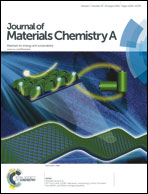A novel porous MgO sorbent fabricated through carbon insertion†
Abstract
A new strategy utilizing carbon insertion to synthesize a highly efficient CO2-capturer through self-dispersion of MgO by co-existing carbon is reported in this paper. Carbon-adulterated magnesia is formed in situ during the carbonization of magnesium acetate for the first time, suppressing the aggregation of MgO nanoparticles and increasing the accessibility of basic sites for CO2. With few carbon particles (about 2%) inside as the adulterant, the porous MgO composites have a surface area of greater than 200 m2 g−1 and a high CO2 adsorption capacity of up to 28 mg g−1 at 473 K, offering a new candidate material for adsorbing CO2 in flue gas vents.


 Please wait while we load your content...
Please wait while we load your content...